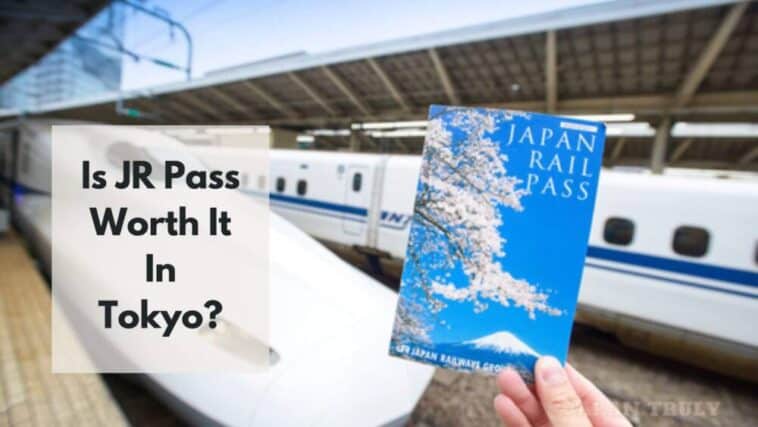Is JR Pass worth it in Tokyo? Find out in this comprehensive guide. We weigh the pros and cons of using the JR Pass in Tokyo, and provide tips on how to decide if the pass is right for you.
The Japan Rail Pass (JR Pass) is a prepaid pass that gives travelers unlimited access to JR trains in Japan for a set period of time.
The pass is available for purchase outside of Japan and must be activated within 3 months of purchase. Once activated, the pass is valid for a set period of time, typically 7, 14, or 21 days.
The JR Pass can be a great way to save money on travel costs in Japan, especially if you are planning on visiting multiple destinations. However, it is important to weigh the cost of the pass against your travel plans to determine if it is right for you.

This article will discuss the benefits and drawbacks of using the JR Pass in Tokyo, as well as how to decide if the pass is worth it for you.
Page Contents
Is JR Pass Worth It In Tokyo?
The JR Pass is a great value for travelers who are planning on visiting multiple destinations in Japan. It can save you a lot of money on transportation costs, and it’s very convenient to use.
If you’re only staying in Tokyo for a few days and plan on using the subway or taxis to get around, then the JR Pass may not be worth it.
But if you’re planning on visiting multiple destinations outside of Tokyo, or if you plan on taking the Shinkansen (bullet train), then the JR Pass is a great way to save money.
Personally, I always buy the JR Pass when I’m traveling to Japan. I think it’s a great way to get around and see the country. But again, it’s important to weigh the cost of the pass against your travel plans and budget to determine if it’s right for you.
- Related: Is Tokyo Metro Pass Worth It?
Understanding the Japan Rail Pass
So, what exactly is this JR Pass? It’s a ticket that allows you unlimited travel on Japan Rail (JR) Group trains, buses, and ferries for a fixed period, typically 7, 14, or 21 days. This pass is available exclusively to foreign tourists visiting Japan.
Benefits of using the JR Pass in Tokyo
There are several benefits to using the JR Pass in Tokyo:
- Unlimited travel on JR trains: The JR Pass gives you unlimited travel on all JR trains in Japan, including the Shinkansen (bullet train). This can be a huge time and money saver if you are planning on visiting multiple destinations outside of Tokyo.
- Access to a wide network of train lines: JR trains operate throughout Tokyo and the surrounding area. This gives you easy access to all of the major tourist attractions in Tokyo, as well as many of the lesser-known gems.
- Convenient and easy to use: The JR Pass is very convenient and easy to use. You simply show your pass to the attendant at the gate and you are good to go. There is no need to purchase individual tickets for each train journey.
- Can save money on travel costs: The JR Pass can save you a lot of money on travel costs, especially if you are planning on visiting multiple destinations in Japan. For example, a round-trip Shinkansen ticket from Tokyo to Osaka costs ¥14,250 (~$129.63 USD). A 7-day JR Pass costs ¥29,650 (~$272.50 USD). If you are planning on visiting multiple destinations in Japan, the JR Pass can easily save you hundreds of dollars on travel costs.
When the JR Pass is not worth it in Tokyo
There are a few situations where the JR Pass is not worth it in Tokyo:
- If you are only staying in Tokyo for a few days and plan on using the subway or taxis to get around: Tokyo has a very efficient subway system that can take you to all of the major tourist attractions in the city. Taxis are also available, but they can be expensive. If you are only staying in Tokyo for a few days and plan on using the subway or taxis to get around, you may not save enough money with the JR Pass to justify the cost.
- If you are not planning on visiting any other destinations in Japan outside of Tokyo: If you are only planning on staying in Tokyo for your entire trip, the JR Pass is not worth it. You can save money by purchasing individual tickets for the train journeys you need.
- If you are traveling on a budget and cannot afford the upfront cost of the JR Pass: The JR Pass can be expensive, especially if you are purchasing a 14- or 21-day pass. If you are traveling on a budget and cannot afford the upfront cost of the pass, you may be better off purchasing individual tickets for the train journeys you need.
How to decide if the JR Pass is worth it for you
To decide if the JR Pass is worth it for you, consider the following factors:
- Budget: How much money are you willing to spend on travel? The JR Pass can be expensive, so it is important to factor the cost into your budget.
- Itinerary: How many days will you be in Tokyo and what do you want to see and do? If you are planning on visiting multiple destinations outside of Tokyo, the JR Pass can save you a lot of money on travel costs.
- Transportation needs: How will you be getting around Tokyo? If you are planning on using the subway or taxis to get around, you may not save enough money with the JR Pass to justify the cost.
Cost Analysis: Is the JR Pass Worth It in Tokyo?
Now, let’s get to the nitty-gritty of our question: Is the JR Pass worth it for getting around Tokyo? To answer this, let’s break down the costs.
If you’re staying mainly in Tokyo and not planning on taking extensive day trips or traveling to other cities, you might find that the JR Pass is not your best option. Here’s why:
- Related: Is Tokyo Wide Pass Worth It?
Calculating Typical Transportation Expenses in Tokyo
In Tokyo, many of your daily travels will likely be within the city itself. For this, the JR Pass might not be the most cost-effective choice. To put things into perspective, a one-way subway or bus ride in Tokyo typically costs around 200-300 yen.
If you plan your travels efficiently, you can limit your daily transportation expenses to a manageable amount.
Comparing the Cost of Individual Tickets vs. JR Pass
The cost of individual train tickets in Japan can vary depending on the distance traveled and the type of train taken. Shinkansen tickets are the most expensive, followed by limited express trains and local trains.
To compare the cost of individual tickets to the JR Pass, you can use the following steps:
- List all of the train journeys you plan on taking.
- Research the cost of each train journey on the Japan Rail Pass website.
- Add up the cost of all of the train journeys.
- Compare the total cost of the individual tickets to the cost of the JR Pass.
Here is an example of a comparison of the cost of individual tickets to the JR Pass:
Individual tickets:
- Tokyo to Osaka (Shinkansen): ¥14,250
- Osaka to Kyoto (limited express train): ¥5,150
- Kyoto to Hiroshima (Shinkansen): ¥13,800
- Hiroshima to Tokyo (Shinkansen): ¥14,250
Total cost of individual tickets: ¥47,450
JR Pass (7 days): ¥29,650
Conclusion: In this example, the JR Pass is cheaper than buying individual tickets for the train journeys listed above.
However, it is important to note that the cost of the JR Pass will vary depending on the number of days you purchase it for.
Assessing the Convenience and Flexibility of the JR Pass
While the JR Pass might not be the best financial choice for in-city travel in Tokyo, it does come with its perks. With a JR Pass, you have the flexibility to use the JR lines within Tokyo.
Special Considerations for Tourists Visiting Nearby Cities
If you’re planning on taking day trips from Tokyo to nearby cities like Nikko or Kamakura, the JR Pass can be a game-changer. These cities are easily accessible by JR lines, and the pass covers the cost of the Shinkansen to these destinations.
If your itinerary includes multiple day trips or exploring different parts of Japan, the JR Pass becomes more valuable.
Using the JR Pass Effectively in Tokyo
Here are some tips on how to use the JR Pass effectively in Tokyo:
- Plan your route in advance: This will help you make the most of your JR Pass and avoid wasting time. You can use the Japan Rail Pass website to plan your route and look up train schedules.
- Make seat reservations: Seat reservations are recommended, especially for long-distance train journeys. You can make seat reservations at any JR ticket office or through the Japan Rail Pass website.
- Use the JR Pass for local trains: The JR Pass also gives you access to local trains in Tokyo. This can be a great way to get around the city and save money on transportation costs.
- Consider using the JR Pass for buses: The JR Pass also gives you access to JR buses in Japan. This can be a great way to get around to destinations that are not accessible by train.
- Be aware of the restrictions: The JR Pass cannot be used on all trains in Japan. For example, it cannot be used on Nozomi and Mizuho Shinkansen trains. You can check the Japan Rail Pass website for a list of trains that are not covered by the pass.
Which JR Lines are Most Useful Within Tokyo
The following JR lines are the most useful within Tokyo:
- Yamanote Line: The Yamanote Line is a loop line that connects all of Tokyo’s major city centers, including Shinjuku, Shibuya, Ikebukuro, Ueno, and Tokyo Station.
- Chuo Line: The Chuo Line runs east-west through Tokyo, connecting Tokyo Station with Shinjuku Station.
- Sobu Line: The Sobu Line runs north-south through Tokyo, connecting Tokyo Station with Ikebukuro Station.
- Keihin-Tohoku Line: The Keihin-Tohoku Line runs parallel to the Yamanote Line on the eastern side of the loop.
- Saikyo Line: The Saikyo Line runs parallel to the Yamanote Line on the western side of the loop.
These five lines are all covered by the JR Pass, so you can use them to get around Tokyo without having to purchase individual tickets.
Here are some specific examples of how you can use these JR lines to get around Tokyo:
- Yamanote Line: Take the Yamanote Line to get to all of Tokyo’s major tourist attractions, such as the Imperial Palace, Tokyo Skytree, and Sensō-ji Temple.
- Chuo Line: Take the Chuo Line to get to Shinjuku Gyoen National Garden, the Tokyo Metropolitan Government Building, and the Ghibli Museum.
- Sobu Line: Take the Sobu Line to get to the Tokyo National Museum, the Asakusa district, and the Ueno Zoo.
- Keihin-Tohoku Line: Take the Keihin-Tohoku Line to get to Tokyo Disneyland, Tokyo DisneySea, and the Tokyo Tower.
- Saikyo Line: Take the Saikyo Line to get to the Ikebukuro Sunshine City complex, the Saitama Arena, and the Seibu Prince Dome.
How to Use the JR Pass for Day Trips from Tokyo
To use the JR Pass for day trips from Tokyo, simply follow these steps:
- Plan your route and look up train schedules. You can use the Japan Rail Pass website to plan your route and look up train schedules.
- Activate your JR Pass at a JR ticket office. You can activate your JR Pass at any JR ticket office in Japan. You will need to show your passport and JR Pass voucher to activate the pass.
- Show your JR Pass to the attendant at the gate before boarding any JR train.
- Enjoy your day trip!
Here are some ideas for day trips from Tokyo that you can take using the JR Pass:
- Hakone: Hakone is a popular tourist destination known for its beautiful scenery, hot springs, and views of Mount Fuji. You can take the Tokaido Shinkansen from Tokyo Station to Odawara Station, and then transfer to the Hakone Tozan Railway to get to Hakone.
- Kamakura: Kamakura is a coastal city known for its many temples and shrines, including the Great Buddha of Kamakura. You can take the JR Yokosuka Line from Tokyo Station to Kamakura Station.
- Nikko: Nikko is a mountain town known for its Toshogu Shrine, a UNESCO World Heritage Site. You can take the Tobu Railway from Asakusa Station to Tobu-Nikko Station.
- Yokohama: Yokohama is a major port city known for its Chinatown, amusement park, and shopping district. You can take the JR Tokaido Line from Tokyo Station to Yokohama Station.
- Kawagoe: Kawagoe is a historic city known for its traditional Japanese architecture and sweets. You can take the JR Tobu Tojo Line from Ikebukuro Station to Kawagoe Station.
Conclusion
So, is the JR Pass worth it in Tokyo? It depends on your travel plans and preferences. If you’re staying mainly in the city and not taking many day trips, the pass might not be the most economical choice.
However, if you’re planning to explore multiple cities and regions in Japan, the JR Pass can save you money and make your journey more convenient.
In the end, the decision is yours, and it should align with your travel style and itinerary.
Regardless of your choice, Tokyo is an incredible city with a transportation system that makes it easy to get around, so you’re sure to have a fantastic experience no matter how you decide to travel.
For more information on the JR Pass and to purchase it, visit official JR Pass website link
JR Pass In Tokyo: FAQs
What is the Japan Rail Pass (JR Pass)?
The Japan Rail Pass, or JR Pass, is a special ticket available exclusively to foreign tourists. It allows unlimited travel on Japan Rail (JR) Group trains, buses, and ferries for a fixed period, typically 7, 14, or 21 days.
How much does the JR Pass cost?
The JR Pass is available in three different durations: 7 days, 14 days, and 21 days. The price of the pass varies depending on the duration and the type of pass you purchase. For example, a 7-day Adult JR Pass costs ¥29,650 (~$272.50 USD).
Where can I buy the JR Pass?
You can buy the JR Pass from authorized travel agents outside of Japan. You cannot buy the JR Pass in Japan.
How do I use the JR Pass?
To use the JR Pass, simply show your pass to the attendant at the gate before boarding any JR train.
What trains are covered by the JR Pass?
The JR Pass covers most JR trains in Japan, including local trains, rapid trains, and Shinkansen (bullet trains). However, the JR Pass cannot be used on all trains in Japan. For example, it cannot be used on Nozomi and Mizuho Shinkansen trains.
Can I use the JR Pass for buses?
Yes, the JR Pass also gives you access to JR buses in Japan. This can be a great way to get around to destinations that are not accessible by train.
Is the JR Pass worth it for in-city travel within Tokyo?
It might not be the most cost-effective choice for in-city travel within Tokyo, especially if you plan on staying mainly within the city. Individual subway and bus tickets are generally more budget-friendly for daily in-city travel.
Can I use the JR Pass for the Tokyo Metro or Toei Subway?
No, the JR Pass cannot be used on the Tokyo Metro or Toei Subway. You will need to purchase separate tickets for these lines.
Can I use the JR Pass for local transportation within Tokyo?
Yes, you can use the JR Pass for some local transportation within Tokyo. The JR Yamanote Line is especially useful for travelers as it connects many major attractions in the city. However, the subway and buses are typically more convenient for in-city travel.
What is the typical cost of transportation in Tokyo without the JR Pass?
On average, a one-way subway or bus ride in Tokyo costs around 200-300 yen. If you plan your travels efficiently, your daily transportation expenses can be kept to a manageable amount.
When does the JR Pass become cost-effective for travelers in Tokyo?
The JR Pass becomes cost-effective when travelers plan on exploring multiple cities and regions in Japan, taking day trips from Tokyo, and using the Shinkansen for long-distance travel. If you’re mainly staying within Tokyo, other transportation options may be more budget-friendly.
Can I use the JR Pass for day trips from Tokyo?
Absolutely! The JR Pass is excellent for day trips from Tokyo. You can easily reach cities like Nikko, Kamakura, and Yokohama by JR lines. The pass covers the cost of the Shinkansen to these destinations, making it a valuable choice for day trips.
What are some tips for optimizing the JR Pass for local travel in Tokyo?
If you decide to use the JR Pass for local travel within Tokyo, focus on using it for day trips and longer journeys. For in-city travel, especially within central Tokyo, the subway and buses are more convenient.
What are the advantages of the JR Pass in Japan?
The JR Pass offers unlimited travel on JR lines, convenience, and flexibility for exploring Japan. It can save you money, especially when traveling between cities and regions. The Shinkansen and JR network make it easy to get around the country.
What are the limitations of the JR Pass in Japan?
The JR Pass can be relatively expensive, especially if you don’t plan on traveling extensively. It’s valid for consecutive days, so you’ll need to plan your itinerary accordingly. It also doesn’t cover all modes of transportation, particularly within major cities like Tokyo and Kyoto.
Are there special discounts or perks for JR Pass holders?
Yes, some attractions and hotels in Japan offer discounts and perks for JR Pass holders. Be sure to check for any special offers that come with the pass, as these can add value to your travel experience.
My writing focuses on the various aspects of Japanese lifestyle, from traditional tea ceremonies and flower arrangement to modern fashion trends and pop culture. Through my articles, I aim to share my passion for Japan and provide readers with a glimpse into the rich and diverse world of Japanese culture.
I believe that the key to understanding Japanese lifestyle is to appreciate the balance between tradition and innovation. While Japan has a rich cultural heritage that dates back centuries, it is also a country that is constantly evolving and embracing new ideas and technologies.
Whether you’re interested in learning about the latest fashion trends in Tokyo, or want to explore the ancient art of calligraphy, my writing will take you on a journey through the many facets of Japanese lifestyle. So join me as we explore the beauty and complexity of this fascinating culture together!





